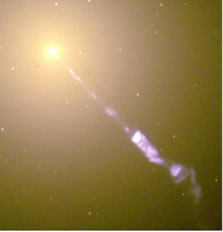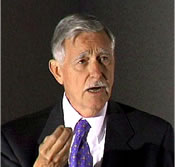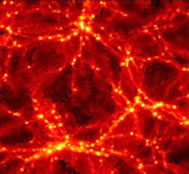holoscience.com | The ELECTRIC UNIVERSE®
A sound cosmology for the 21st century

The Remarkable Slowness of Light
“The more one reflects on the nature of light, matter and gravitation, the more he realizes that there are problems connected with them that are quite insoluble in terms of our current notions. But we no longer reflect intelligently on these things.”
Herbert Dingle, Science at the Cross-Roads.
The following report comes from the BBC, 8 August, 2002:
Einstein’s theory ‘may be wrong’
The theory that the speed of light is always constant has come under fire. Australian physicists propose that it may have slowed over the course of billions of years. It’s entirely possible that the speed of light would have got greater and greater as you go back towards the Big Bang. Paul Davies, the theoretical physicist said: “If true, it would mean a rethink of Einstein’s theory of relativity.”
The idea is floated in a brief communication in the journal Nature.
It is based on astronomical data involving light from a quasar, a very distant star-like object. Observations suggest the light has taken about 10 billion years to reach the Earth. What is more, a key constant involving the interaction of light photons and electron particles seems to have changed. It appears to have been smaller 10 billion years ago.
According to Paul Davies, a physicist at Macquarie University, Sydney, this can be explained only if the speed of light or electron charge has changed since then. “But two of the cherished laws of the Universe are the law that electron charge shall not change and that the speed of light shall not change, so whichever way you look at it we’re in trouble,” he says.
Star Trek hope
Studies on black holes suggest that the second option is more likely, according to Davies’ team. The theoretical physicist believes the speed of light was faster six to 10 billion years ago than its current value – 300,000 km (186,300 miles) per second. “It’s entirely possible that the speed of light would have got greater and greater as you go back (through time) towards the Big Bang and if so it could explain some of the great mysteries of cosmology,” he says. He admits that further work on light from quasars is needed to firm up the theory. In addition, the physics of black holes are known to be extremely shaky. But there are startling implications if the law that nothing can go faster than light is overturned.
“Maybe it’s possible to get around that restriction, in which case it would enthral Star Trek fans because at the moment even at the speed of light it would take 100,000 years to cross the galaxy,” says Davies. It’s a bit of a bore really and if the speed of light limit could go, then who knows? All bets are off.”
“It is usually taken for granted that the processes of mathematics are identical with the processes of reasoning, whereas they are quite different. The mathematician is more akin to a spider than to a civil engineer, to a chess player than to one endowed with exceptional critical power. The faculty by which a chess expert intuitively sees the possibilities that lie in a particular configuration of pieces on the board is paralleled by that which shows the mathematician the much more general possibilities latent in an array of symbols. He proceeds automatically and faultlessly to bring them to light, but his subsequent correlation of his symbols with facts of experience, which has nothing to do with his special gift, is anything but faultless, and is only too often of the same nature as Lewis Carroll’s correlation of his pieces with the Red Knight and the White Queen – with the difference whereas Dodgson recognised the products of his imagination to be wholly fanciful, the modern mathematician imagines, and persuades others, that he is discovering the secrets of nature.”
– Herbert Dingle, Science at the Cross-Roads, (1972) pp. 127-8.
COMMENT: For many years Prof. Dingle wrote the entry for special relativity in the Encyclopedia Brittannica until he notoriously recanted. The nonsensical responses to his simple argument against Einstein led him to publish the book from which the quotes are taken. Einstein’s legacy lives on. There are so many assumptions hidden beneath the thinking in the above report that it should have been published in the Star Trek Manual, not the science journal, Nature. It is the second “scientific” report to refer to Star Trek in recent months. The other, also from Australia, raised the future possibility of teleportation (“Beam me up Scottie”).
Both reports exhibit the malaise in physics brought about by its disconnection from reality and the modern need to indulge in show business to gain recognition and funding.
We still have no idea what light is. Our confusion is evident when we talk about a photon in one experiment and an electromagnetic wave in another. Maxwell is supposed to have mathematically described the electromagnetic wave, but he required a medium the ether for its transmission. Einstein “thought” the ether away but no one is quite sure how he did that, even though the Michelson-Morley experiment was supposed to have clinched it.
“… Lorentz, in order to justify his transformation equations, saw the necessity of postulating a physical effect of interaction between moving matter and ether, to give the mathematics meaning. Physics still had de jure authority over mathematics: it was Einstein, who had no qualms about abolishing the ether and still retaining light waves whose properties were expressed by formulae that were meaningless without it, who was the first to discard physics altogether and propose a wholly mathematical theory.”
– Herbert Dingle, Science at the Cross-Roads, pp. 165-6.
The fact remains that everything we know about electric and magnetic fields requires electric charges, in other words, a medium, as a focus for the fields. If there is to be a wave, there must be something to wave!
We know that the “vacuum” of space is teeming with neutrinos. Countless trillions of the ghostly particles pass through each square centimetre every second. Maybe neutrinos constitute the medium of “empty” space? It makes sense if, as I suggest elsewhere on this site, all particles are composed of orbiting massless electric charges. And neutrinos are the most collapsed form of particle.
“All hope to restore some unity is not lost, though. To start with, even in the absence of any theoretical or experimental proof, it is not unreasonable to assume that the particles known today are actually composites, and that their eventual description (which remains to be discovered) will involve a smaller number of new and truly elementary constituents.”
– Etienne Klein & Marc Lachièze-Rey, THE QUEST FOR UNITY – The Adventure of Physics.
This brings us to the speed of light, “c.” We know from experiment that “c” varies depending on the medium. More particularly, “c” varies depending on the electrical characteristics of the medium. The speed of light in a vacuum cannot then be simply declared a universal constant, because a vacuum is not empty space it is filled with vast but varying numbers of neutrinos and some other particles.
It seems more reasonable to suggest that the speed of light is the speed with which an oscillating electrical disturbance is transmitted through a dielectric medium. The speed of light is highest in a medium where the rate of charge polarization in the particles of that medium is greatest. Neutrinos, having the lowest mass, or inertia, of any particle, have the fastest rate of internal charge polarization and response to an electric field. Therefore “c” is a maximum in a vacuum, paradoxically full of neutrinos.
The notion that c was considerably faster in the past has appeal to both cosmologists and creationists. Both camps have severe difficulties in explaining the observed universe, even with their vastly different time frames, unless things happened much faster initially. Cosmologists would like to see a near infinite speed of light immediately following the big bang and creationists about 10^11 times “c.” Both are misled by their misunderstanding of the creation myths. It was no accident that a Belgian priest, Georges LeMaitre, proposed the big bang theory, as it came to be known. Science is as much driven by culture and religion as any other human activity.
Proof that the cosmologists are mistaken both in their speculations about light-speed and the big bang hypothesis comes from the very source referred to in the above report the light from a quasar. The above-quoted article says that the quasar is 10 billion light years distant. That is based on the most peculiar big bang theory that the volume of the universe is increasing. It follows the observation that faint objects have their spectrum shifted towards the red. The discoverer of this phenomenon, Edwin Hubble, was careful to not attribute this “redshift” to the Doppler effect of the velocity of recession of the object, but theorists were not so circumspect. The redshift velocity – distance equation quickly became another of the many dogmatic assumptions of cosmology.
 The astronomer, Halton Arp, plays the role of a modern Galileo in this story. He discovered that redshift is largely intrinsic to a quasar and is a measure of its youth, not its distance. The faint, unresolved star-like quality of a quasar is because it is a baby galaxy, recently born with high-redshift and low brightness from a nearby low-redshift active galaxy. The quasar referred to by Davies is nearby and faint, not 10 billion light years distant. He is not looking at 10 billion-years-old light. Such a discovery lays waste to big bang cosmology. The response of the cardinals of astronomy, now as in Galileo’s time, was to refuse to see what Arp had discovered and, in effect, to take his telescope away from him.
The astronomer, Halton Arp, plays the role of a modern Galileo in this story. He discovered that redshift is largely intrinsic to a quasar and is a measure of its youth, not its distance. The faint, unresolved star-like quality of a quasar is because it is a baby galaxy, recently born with high-redshift and low brightness from a nearby low-redshift active galaxy. The quasar referred to by Davies is nearby and faint, not 10 billion light years distant. He is not looking at 10 billion-years-old light. Such a discovery lays waste to big bang cosmology. The response of the cardinals of astronomy, now as in Galileo’s time, was to refuse to see what Arp had discovered and, in effect, to take his telescope away from him.
“The greatest part of the progress independent researchers have made in the past decades, in my opinion, is to break free of the observationally disproved dogma of curved space time, dark matter, Big Bang, no primary reference frame and no faster than light information.”
– Halton Arp, The Observational Impetus For Le Sage Gravity.
The picture of the universe given to us by Arp makes far more sense than the big bang. We see only a small part of an immensity of unknown extent and origin. The objects around us are almost static and form discernible families with parent active galaxies giving birth to quasars in the jets from their cores. The quasars grow more massive with time and slow down to become companion galaxies. Their redshift decreases as they age.
The plasma cosmologists further show us that the entire process is driven electrically, the power being delivered by a vast cosmic web of power lines originating from beyond the visible universe. The galaxies are strung like beads on a string along those power lines.

<< This computer simulation image shows large-scale structure in the universe, known as the cosmic web. Galaxies line filaments of matter like pearls on a string, and galaxy clusters arise where filaments meet.
Be aware that this image is highly distorted because the galaxies have been placed by the computer at their redshift distances. It has been responsible for the “fingers of God,” illusion, where echelons of galaxies appear to point toward us. Commonsense should have sounded the alarm bells immediately for theorists, instead of reverential awe. Nonetheless galaxies do form linear chains. Such structure is not expected from a gravity-driven formation of the Universe. However, it is expected from plasma cosmology, where galaxies form at the intersection of two intergalactic Birkeland current filaments.
Something else that is never mentioned in polite scientific company is the astounding discovery by Arp and William Tifft that the redshift of quasars and galaxies is quantized! It has led to the false impression of “great walls” of galaxies at various distances from us. That too, should have set off another loud alarm. It spotlights the inadequacy of a purely mathematical quantum theory, divorced from any classical physics underpinning, and the nonsense that it only applies to the subatomic realm. If Einstein got anything right, it was his suggestion that quantum theory pointed to some lower level of complexity in particle physics, instead of requiring the removal of the foundation stone of physics causality. His god was not a gambler.
I agree with Davies that the charge on the electron has not changed. But neither has the speed of light. Unlike Davies, it seems to me that the basis of the physical universe is electric charge, governed by a near-instantaneous electrostatic force. All forms of matter and its interactions spring from that simple basis. Every particle and collection of particles is a resonant system of orbiting charges, from which comes resonant quantum effects and the manifestation of inertial mass. Resonance explains the puzzling non-radiating ground-state of an atom. Gravity, magnetism and nuclear forces can all be understood in terms of electric dipole forces between distorted systems of orbiting charge. Einstein is not required. Space cannot be warped or expand. Time is effectively universal and has nothing to do with space. Black holes do not exist. It is an ELECTRIC UNIVERSE®.

There is no crisis of theory in an ELECTRIC UNIVERSE®. The speed of light in a vacuum depends only upon the nature of the vacuum. A vacuum is not empty space. However, “c” is unlikely to vary significantly in space. “c” has no connection with the size or age of the universe. Size and age are meaningless concepts anyway, given Arp’s clearsighted view of the cosmos. But can the ELECTRIC UNIVERSE® offer any explanation for the redshifts?
I think so. We know from Arp’s careful observations that quasars are episodically ejected in pairs in opposite directions along the spin axis of an active galaxy. The brightness of the quasars is higher and their redshift lower the further away we find them from their parent active galaxy, and therefore the older they are. Their mass seems to increase with age and they slow down to eventually go into orbit about the parent as a companion galaxy.
Plasma cosmology provides the insights into what is going on in the centers of active galaxies. It does not require a mythical black hole, merely a plasma focus effect. A plasma focus effect is the result of a cylindrically symmetrical electrical discharge. It provides the most concentrated form of electrical energy known. It takes the shape of a tiny plasma donut, or plasmoid, lying in the plane of the spiral galaxy and at its center. The plasmoid accumulates electrical energy from along the spiral arms until it suddenly begins to break down, forming an intense jet of neutrons, particles and radiation along its axis. Electrons, being much lighter, are trapped in the focus for a longer time. The neutrons in the jet begin to decay into protons and electrons, forming hydrogen atoms and some heavier elements, by neutron capture. (Given the extreme electromagnetic environment, we should not expect the neutron decay characteristics to mimic those seen on Earth). The material in the jet forms a “knot” and becomes an electron deficient (positively charged) quasar.

Meanwhile, electrons are being slowly released by the decaying galactic plasmoid and they stream in a thin beam after the quasar. They form the great radio jets seen emanating from the nuclei of active galaxies.
It seems that as the quasar attracts electrons its matter becomes progressively more polarized, or massive, as Arp found. It is similar to what we observe in particle accelerators the more a particle is distorted, or polarized, in an electric field, the more massive it appears to become. If an electron orbiting a nucleus becomes progressively more massive in a globally changing electrical environment, it will require to compensate at intervals by executing small quantum jumps to new resonant orbits closer to the nucleus. The energy of those orbits will be higher and the result is a quantized shift away from the red end of the spectrum. The quasar becomes brighter and less redshifted. It is not closer.
“The idea then arose that it [the electron] was a sort of mist of electricity, and Eddington probably gave it the most candid description as ‘something unknown doing we don’t know what.’ We are no wiser today; nevertheless, we speak of the mass of an electron as though it were equivalent to the mass of a lump of lead.”
– Herbert Dingle, Science at the Cross-Roads, pp. 141-2.
It is the lower energy electron orbits in new quasar atoms that may give rise to the effect remarked upon by Davies and his co-workers. If so, it is due to a different inertial mass of an electron in a quasar atom, not a different speed of light 10 billion years ago. The result is simply that Planck’s constant and consequently the fine structure constant will differ by a very small amount from that measured on Earth. Once again we see the trouble caused by arbitrarily assuming universality of physical constants measured on Earth.
Another serious problem faced by conventional thinking is that the quantum shifts seem to occur galaxy-wide without delay. No object has been found with two different redshifts. Yet a change propagating at the speed of light would take something like 100,000 years to traverse a galaxy. It seems that the kind of particle dipole distortions that create inertial mass and gravity propagate at the near infinite speed of the electrostatic force. So, once begun, the quantum shift in atomic orbitals could spread across a galaxy in less than a second. I suppose it could be termed “galactic quantum entanglement.”
So, the good news for Star Trek fans is that Einstein’s speed limit is repealed. But the Warp Drive and Teleporter are out, I’m sorry. They are illogical. Space cannot be warped. And matter can neither be destroyed nor created, despite the widespread misconception that the “m” in E = mc^2 means matter, and that antimatter annihilates matter. [The only possibility that I can imagine for a Teleporter would be to create an identical physical copy from materials already to hand at the receiver. But there is far more to biology than meets the scientific reductionist eye. Would the copy be alive? And if so, who, if anyone, would it be? And what do you do with the original – kill it and dispose of the body in the process?]
Despite all of these absurdities, gravitational big bang cosmology still comes out the clear winner in the science fiction category.
As for Prof. Davies recent book, How to Build a Time Machine save your money, space fans, and put it into antigravity research! As taxpayers we pay dearly for this fiction anyway.
 The genius, Lou Jacobs, like many other well-publicised clowns, allows himself to be blown away by the big bang.
The genius, Lou Jacobs, like many other well-publicised clowns, allows himself to be blown away by the big bang.
It is incredible that we entered the 21st century with an advanced technology that is crucially dependent upon electricity and yet a cosmology where the powerful electrical force has no role, when we know that electric charge is the foundation of all the matter in the universe.
Davies’ bewilderment is understandable, “If what we’re seeing is the beginnings of a paradigm shift in physics like what happened 100 years ago with the theory of relativity and quantum theory, it is very hard to know what sort of reasoning to bring to bear.”
Precisely. The revolution in thinking will not come from the present generation of theoretical cosmologists. It must come from the next generation of practical electrical engineers, plasma physicists and observational astronomers.
“…I have no doubt that there will arise a new generation who will look with a wonder and amazement, deeper than now accompany Einstein, at our galaxy of thinkers, men of science, popular critics, authoritative professors, and witty dramatists, who have been satisfied to waive their common sense in view of Einstein’s absurdities. Then to these will succeed another generation, whose interest will be that of a detached and half-amused contemplation; and in the limbo of forgotten philosophies they may search for the cenotaph of Relativity.”
– Arthur Lynch, The Case Against Einstein, Dodd, Mead & Co., New York, 1933.
© Wal Thornhill 2002